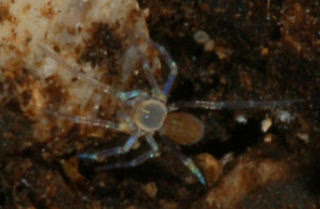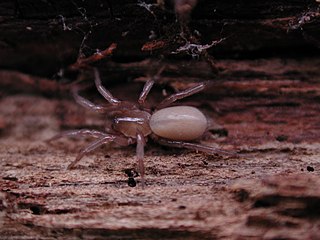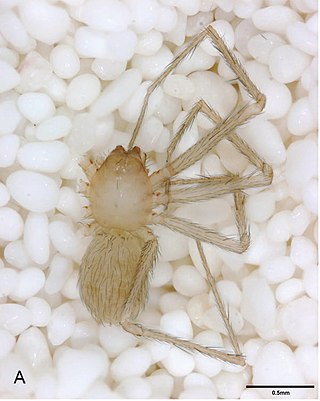
Crevice weaver spiders (Filistatidae) comprise cribellate spiders with features that have been regarded as "primitive" for araneomorph spiders. They are weavers of funnel or tube webs. The family contains 18 genera and more than 120 described species worldwide.

The Tooth Cave spider, formerly Neoleptoneta myopica, now Tayshaneta myopica, is a 1.6 mm long spider in the family Leptonetidae. It is endemic to limestone caves near Austin, Texas in the United States and is considered an endangered species.

Leptonetidae is a family of small spiders adapted to live in dark and moist places such as caves. The family is relatively primitive having diverged around the Middle Jurassic period. They were first described by Eugène Simon in 1890.
Neoleptoneta is a genus of North American leptonetids that was first described by Paolo Marcello Brignoli in 1972.

The Leptonetoidea are a superfamily of haplogyne araneomorph spiders with three families. Phylogenetic studies have provided weak support for the relationship among the families. The placement of one of the families within the Haplogynae has been questioned.

The Haplogynae or haplogynes are one of the two main groups into which araneomorph spiders have traditionally been divided, the other being the Entelegynae. Morphological phylogenetic studies suggested that the Haplogynae formed a clade; more recent molecular phylogenetic studies refute this, although many of the ecribellate haplogynes do appear to form a clade, Synspermiata.

Cicurina, also called the cave meshweaver, is a genus of dwarf sheet spiders that was first described by Anton Menge in 1871. Originally placed with the funnel weavers, it was moved to the Dictynidae in 1967, then to the Hahniidae in 2017. The name is from the Latin root "cucur-", meaning "to tame".
Appaleptoneta is a genus of North American Leptonetids that was first described by Norman I. Platnick in 1986.
Archoleptoneta is a genus of North American spiders that was first described by Carl Eduard Adolph Gerstaecker in 1974. As of May 2019 it contains only two species, both found in the United States: A. gertschi and A. schusteri.
Calileptoneta is a genus of North American Leptonetids that was first described by Norman I. Platnick in 1986.
Chisoneta is a genus of North American Leptonetids that was first described by J. Ledford in 2011.
Darkoneta is a genus of spiders that was first described by J. M. Ledford & C. E. Griswold in 2010.
Montanineta is a monotypic genus of North American leptonetid spiders containing the single species, Montanineta sandra. It was first described by J. Ledford in 2011, and has only been found in the United States.
Ozarkia is a genus of North American leptonetids that was first described by J. Ledford in 2011.
Titanebo is a genus of North American running crab spiders that was first described by Carl Eduard Adolph Gerstaecker in 1933.

Apollophanes is a genus of running crab spiders that was first described by Octavius Pickard-Cambridge in 1898.

Clubiona pallidula is a species of sac spider in the family Clubionidae. It is found in Europe, Caucasus, a range from Russia to Central Asia, and has been introduced into North America.
Archoleptonetidae is a family of spiders in the order Araneae. There are two genera and about eight described species in Archoleptonetidae. They are known from the western USA, southern Mexico, Guatemala, and Panama. This family was formerly a subfamily of Leptonetidae.

Tayshaneta microps, synonym Neoleptoneta microps, is a rare species of spider in the family Leptonetidae known by the common name Government Canyon bat cave spider. It is endemic to Texas in the United States, where it is known to be found in two caves in Bexar County. It is a troglobite, an animal which spends its entire life in caves. It is one of nine Bexar County troglobites which were listed as endangered species in 2000.








